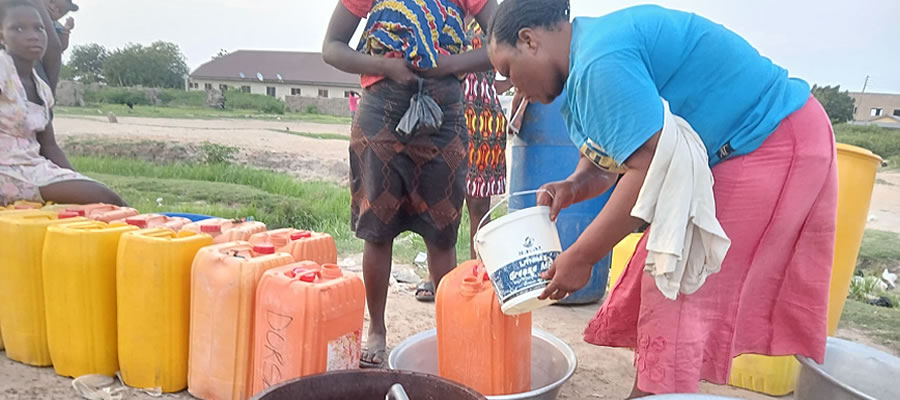

The Ada West District is among the sixteen districts in the Greater Accra Region and it is situated in the south-eastern corner of Ghana. It is carved out of the former Dangme East in the year 2012 and it is established by the Legislative Instrument 2129 of 2012.
The District lies between Latitudes 5°45’S and 6°00’N and Longitude 0°20’W and 0°35’E. The total land area of the District is approximately 323.72 Square km, which is about 10% of the total land size of the Greater Accra Region.
The District shares common boundary with the North Tongu District of the Volta Region to the North, Ada East to the East, NingoPrampram District to the West and to the South by the Gulf of Guinea, which stretches over 45 Kilometres (27.9 miles) from Wokumagbe through Goi to Kablevu. Sege is the District capital, and it lies about 80 Kilometres from Accra on the Accra –Aflao road.
Geology & Soil
A large portion of the District is underlain by tertiary and recent alluvial deposits. A small section of the northern and eastern parts (between Afiadenyigba and Sege) fall under the Dahomeyan complex rocks of Precambrian age. The recent unconsolidated sand, clay and gravel occur in the deltaic areas surrounding the Songhor Lagoon. The rock of the basement is unknown, but it is expected to be Dahomeyan, similar to that cropping to the north of the basin. The suitable soil formed from these soil associations is the Tojeh and Koloidaw series. These soil types vary from red to brown deep (120-150cm) to very deep (>150cm) well to moderately drained fine sandy clay loams to sandy clay. The soil formed under these rocks supports a variety of tropical crops which sustain the agricultural activities in the district.
The District is well endowed with a large deposit of salt which is the main economic resource. Salt mining provides employment for a large number of the population particularly in areas where the resource exists. The Ada West District Assembly generates about 70% - 75% of her internal revenue from the salt industry. The major company in the salt industry is the Songhor Salt Project.
Songhor Salt
The Songhor Salt is the major mining company in the district and is located on the Songhor Lagoon which covers a total land area of about 12,500 acres. The Project employed a total labour force of about 300 and produces approximately 90,000 metric tonnes of salt annually to meet the demands of both the local and international markets in Togo, Burkina Faso, Mali and Nigeria. Under full production capacity, the project is expected to generate more than 1,500 employments to the youth. Feasibility studies and empirical evidence have adjudged the industry to have tremendous capabilities to support the proposed Petro-chemical Industry including the production of Caustic soda, Chlorine and PVC Pipes etc.
Topology & Drainage
The Ada Wet District is part of the central portions of the Accra Plains. Almost flat, the Accra Plains descend gradually to the gulf from a height of about 150 meters. The relief is generally gentle and undulating, a low plain with heights not exceeding 60 meters (200 ft.) above sea level. The topography is marked by a succession of ridges and spoon shaped valleys. The hills and slopes in the area are the favoured lands for agricultural development. Continuous cropping is the usual agricultural practice whereby ploughing and cropping is done across the slopes. A plan to irrigate the area could enhance opportunity for large-scale investment in the agriculture, aquaculture and livestock production.
Drainage
The general drainage pattern of the Ada West District can be described as dendritic with some of the streams taking their sources from the Volta River. Water bodies such as Pagaga in Anyamam, Akplaba in Akplabanya, Kablu in Sege, Woku in Wokumagbe and Taliba in Talibanya among others, are the main streams and lagoons that drain the district. The Gulf of Guinea in the south also contributes to the drainage system of the district. The volume of water received by these water bodies depend on the season and the effect of climate change on the district. Most of these water bodies are seasonal in nature as they dry up in the dry season resulting in severe water shortage in the district for both domestic and agricultural purpose.
In the district, quite a sizeable portion of the land particularly in the southern sector is dominated by lagoons. In areas such as Wokumagbe, Akplabanya, Anyamam, and others, the lagoons are poorly managed resulting to not only serious environmental sanitation challenges but also making the area prone to flooding. These are potential threats to the general health condition of the people living in these areas. The Lagoons are among the major natural resource being exploited by both the indigenes and other
migrants for their economic benefit.
Date Created : 11/28/2017 4:29:42 AM










 facebook
facebook
 twitter
twitter
 Youtube
Youtube
 +233 593 831 280
+233 593 831 280 0800 430 430
0800 430 430 GPS: GE-231-4383
GPS: GE-231-4383 info@ghanadistricts.com
info@ghanadistricts.com Box GP1044, Accra, Ghana
Box GP1044, Accra, Ghana